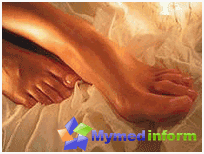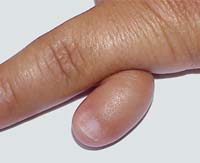Appearance «cones» On the feet, experts are explained by drinking under the skin of the head of one of the bones. Instead of beautiful shoes, a woman has to wear a shapeless mushroom shoes. Over time, the gait becomes severe, the inhydration occurs. In addition, the swollen joint causes pain, edema, corn and inflammation. However, this is not all. How to recognize Valgus Stop deformation?
Content
The main manifestations of the Valgus deformation of the thumb
-
The presence of a discovering seal («Shishchechki») in the field of transition of the thumb in the foot
-
Hyperemia (redness) and some swelling of soft tissues in this area.
-
Corn formation in the area of softening soft tissue.
-
Pain of various severity in the field of discovering bid.
-
Visible deformation in the footage: At the same time, a bone head displacement (a bone in the base of the thumb) was noted, and the largest duck.
 Of course, the diagnosis of the Valgus deformation of the thumb of the foot does not require any special research methods. This pathology is visible at the first inspection. However, all the same additional diagnostic methods are necessary to clarify the state of bone tissue and joints, as well as the degree of deformation.
Of course, the diagnosis of the Valgus deformation of the thumb of the foot does not require any special research methods. This pathology is visible at the first inspection. However, all the same additional diagnostic methods are necessary to clarify the state of bone tissue and joints, as well as the degree of deformation.
Most often, a radiographic study is used for hughus deformation. It is carried out in order to identify the causes of the disease, possible deformations of the bones of the foot, flatopy, as well as to estimate the state of the joints on the foot. Radiography of the foot at the valgus deformation of the thumb usually takes the front-rear projection. For suspicion of concomitant flatfoot, radiography is carried out in the side projection, and with the load.
On radiographs of the joint of the foot of the foot, even the sublizes of the phalanx (bones) of the thumb may even be celebrated.
With prolonged course of the disease, such a state may develop such as a contracture (limitedness of movement, stiffness) muscles extending the thumb of foot. This is manifested by the restriction of extensitive movements by this finger. It is very characteristic with the long flow of Valgus deformation and plantar keratosis – This thickening of the horn layer of the skin in the base of the thumb. In principle, it can even be called a corner.
Four Stages of Valgus Large Foot Straight
-
In the first, initial stage of the disease, there is an excessive displacement of the thumb under the influence of close shoes, which gradually leads to an increase in mobility in the joint. It takes stretching of the so-called domestic seismine ligament and reduce outdoor semensoidal ligament. This contributes to the weakening of the ligament apparatus of the PlusNeflangy joint and leads to the emergence of the external sublifting of the thumb.
-
The second stage is characterized by a further displacement of the thumb in relation to the tie. There is a shift of the tendons of the thumb shimeliers.
-
In the third stage of the disease, a further formation of a large-finger shift. At this stage, certain changes from the soft tissue are usually arising due to a long-term compression of close shoes. The shishche in the joint area is now formed not only due to the very displacement of the head of the tight bone of Knuts, but also due to the development of bone growth, as well as the occurrence of corn.
-
At the fourth stage, in addition to the fact that there is a complete separation of the articular surfaces of the ventiome bone and phalanxes, complications in the form of inflammation, infection and T.D., as well as the development of trophic disorders (an ulcer is formed).









